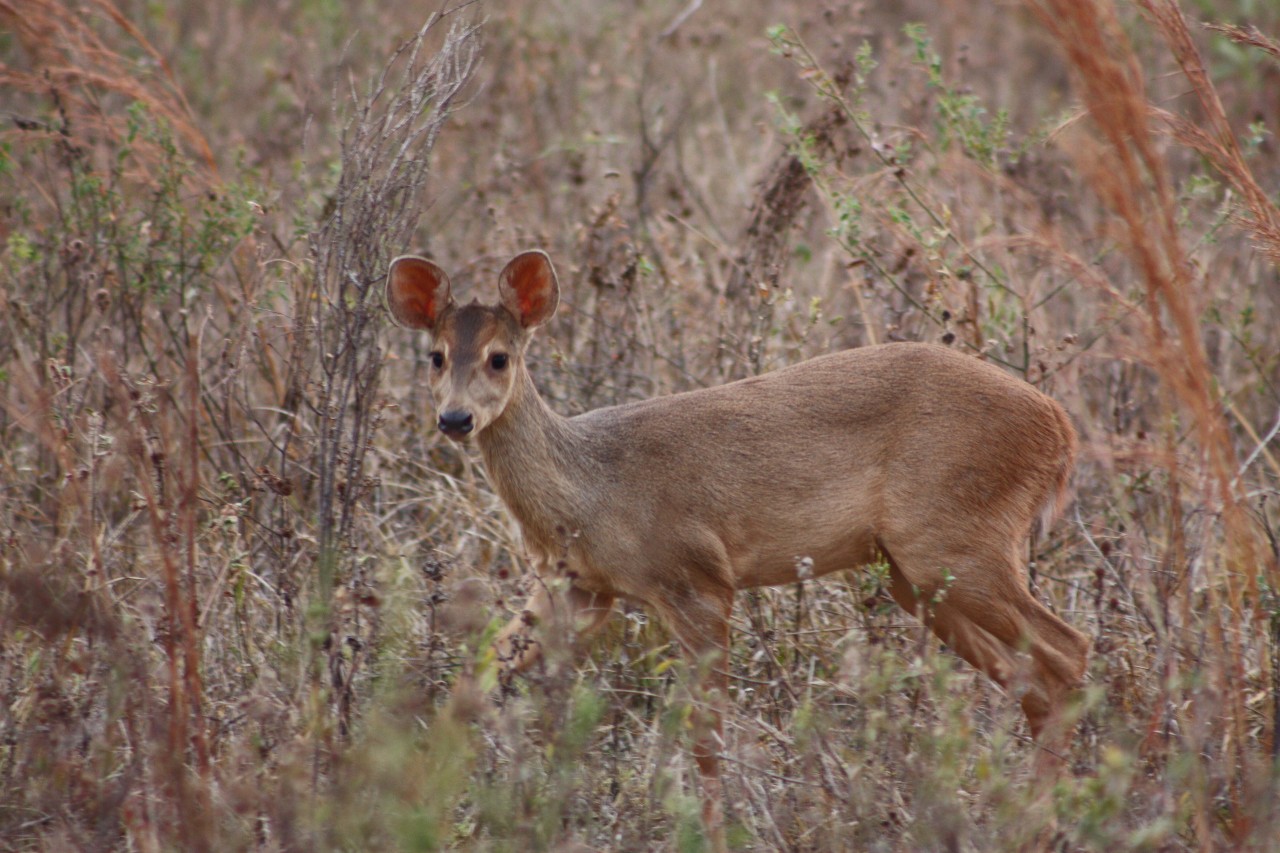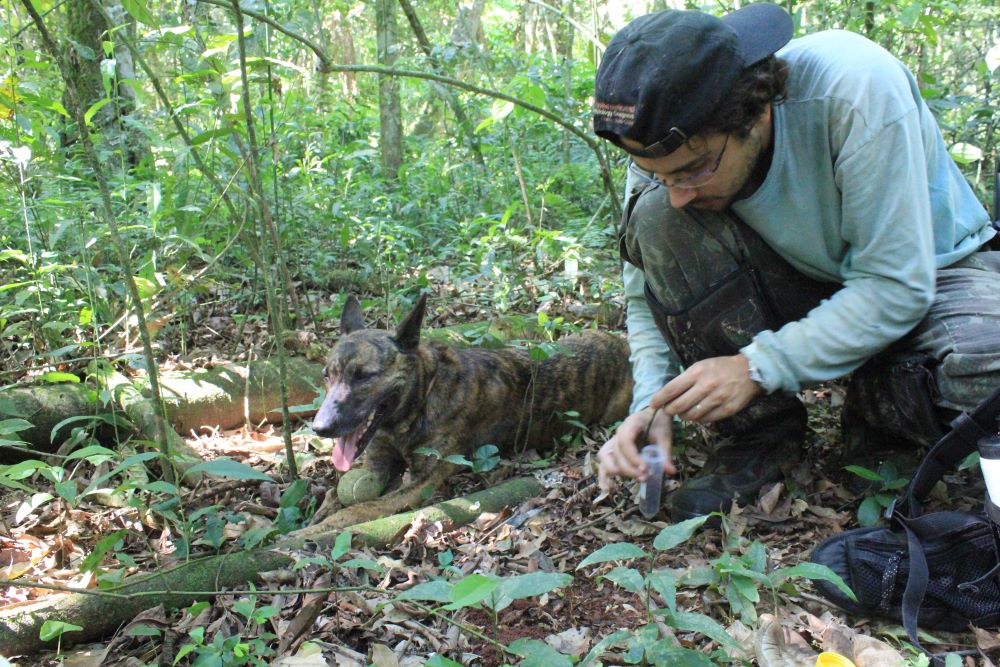

The cattledove (Subulo gouazoubira), one of the species found in the Atlantic Rainforest, is suffering from hunting and other anthropogenic pressures (photo: Pedro H. F. Peres)
The most robust estimate ever made in the biome shows that hunting, predation by domestic dogs, livestock diseases and competition with wild boars are among the main anthropogenic influences. Scientists used an innovative method involving trained dogs and fecal DNA analysis.
The most robust estimate ever made in the biome shows that hunting, predation by domestic dogs, livestock diseases and competition with wild boars are among the main anthropogenic influences. Scientists used an innovative method involving trained dogs and fecal DNA analysis.

The cattledove (Subulo gouazoubira), one of the species found in the Atlantic Rainforest, is suffering from hunting and other anthropogenic pressures (photo: Pedro H. F. Peres)
By André Julião | Agência FAPESP – A group of Brazilian researchers has, for the first time in the entire Atlantic Rainforest, estimated the population density of the five deer species of the biome. This allowed them to measure the main factors that influence the number of deer per square kilometer (km²) in forest areas.
The results suggest a strong relationship between the low animal densities and human pressures such as hunting, predation by domestic dogs, livestock-borne diseases, and competition with wild boar, an invasive species that consumes the same resources as deer.
The study was published in the Journal of Applied Ecology.
“Deer that live in forests are the most difficult to spot and therefore to assess their population density. This is an essential metric for conservation and one that we’ve only just managed to obtain after more than a decade of effort,” says Márcio Leite de Oliveira, professor at the University of Araraquara (UNIARA) and first author of the article.
Oliveira carried out part of the study during his postdoctoral research, which he conducted with a scholarship from FAPESP at the Deer Research and Conservation Center (NUPECCE) of São Paulo State University (UNESP), in Jaboticabal.
The estimates are based on samples collected at 31 points in 21 conservation units representing the Atlantic Rainforest, from the Northeast to the South of Brazil. The deer feces were located by specially trained dogs. The researchers then used fecal DNA analysis to identify the species.

Researcher Márcio Leite de Oliveira collects deer droppings found by his trained dog, Granada (photo: Jorge Alfonso Morales Donoso)
The density estimation method developed by the group and previously used in other studies also includes statistics that take into account the defecation rate of each species (read more at: revistapesquisa.fapesp.br/en/dogs-working-in-the-forest/ and agencia.fapesp.br/37739/)
Due to the robustness of the data, they were included as indicators in the National Action Plan for the Conservation of Ungulates, a public policy of the Brazilian Ministry of the Environment and Climate Change (MMA) for this group of animals.
In the now published study, the researchers also recorded environmental data such as vegetation type, altitude and slope. Finally, a survey was conducted at each site to identify human threats, which were assigned an index of 0, 1, or 2, with zero representing total absence and two representing high prevalence.
“Although the direct relationship between deer population density and threats was expected, it’d never been demonstrated as robustly as we have now. The work therefore provides a strong body of evidence to support the management of protected areas and the conservation of the species,” explains Oliveira.
Situation
The lowest density found was 0.14 individuals per km² for roe deer (Mazama rufa) in the Araucárias National Park, in the state of Santa Catarina. The highest was found in the Sooretama Biological Reserve, in the state of Espírito Santo, with 18.17 red deer (Passalites nemorivagus) per km².
The case of red deer was an exception. In the sampled areas, the average densities ranged from 1.47 to 3.42 individuals per km².
Anthropogenic influence (resulting from human activity) had the greatest effect on deer density, outweighing natural factors such as altitude, slope, and latitude. In addition to correlating with environmental monitoring and rates of plant exploitation at the sites studied, the presence of hunters, domestic dogs (which can prey on deer), cattle (which can transmit diseases) and wild boars (which compete for resources and can also transmit diseases) were also verified.
In one case, however, human presence favored the animals: the number of park rangers. “The density of professionals working in the conservation units influenced the density of deer. The more park rangers, the more deer could be detected in an area,” says Oliveira.
Another study by the group had already shown the importance of protected areas for deer. At that time, the researchers pointed out that protecting just 2% more of the Atlantic Rainforest would bring benefits for the conservation of at least three deer species (read more at: agencia.fapesp.br/40179/).
“The work now published provides a parameter of the current situation of cervids in the Atlantic Rainforest. The ideal would be to repeat these estimates every five or ten years and see where it has stayed the same, where it has increased and where it has decreased. In this way, conservation could be guided by evidence,” concludes the researcher.
Other co-authors also carried out their research with scholarships from FAPESP (17/00331-8, 17/02200-8 and 19/07655-9), under the guidance of José Maurício Barbanti Duarte, professor at the School of Agricultural and Veterinary Sciences (FCAV) of UNESP and coordinator of NUPECCE.
In addition to Barbanti, the study’s supervisors include Fernando de Camargo Passos, coordinator of the Laboratory of Biodiversity, Conservation and Ecology of Wild Animals (LabCeas) at the Federal University of Paraná (UFPR).
The article “Lower ungulate population density in rainforests under anthropogenic influences” can be read at: besjournals.onlinelibrary.wiley.com/doi/epdf/10.1111/1365-2664.14858.
Republish
The Agency FAPESP licenses news via Creative Commons (CC-BY-NC-ND) so that they can be republished free of charge and in a simple way by other digital or printed vehicles. Agência FAPESP must be credited as the source of the content being republished and the name of the reporter (if any) must be attributed. Using the HMTL button below allows compliance with these rules, detailed in Digital Republishing Policy FAPESP.





